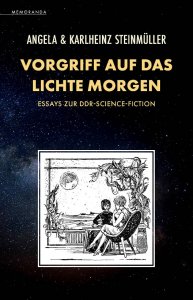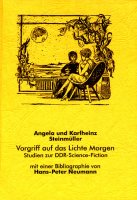Vorgriff auf das Lichte Morgen. Essays zur DDR-Science-Fiction (Anticipations of a Bright Tomorrow. Essays on East German Science Fiction)

Memoranda Publ. Berlin, 2023
Looking back at forty years of East German science fiction is not an easy task. About 150 novels and more than one thousand stories have to be considered, you simply cannot give justice to each individual voice, to each interesting book. At best it is possible to sketch an outline of the general tendencies, and of the different mutations the genre took during the four decades. East German SF had little traditions to build upon. The earlier German SF of the Third Reich – epitomised in the novels of Hans Dominik – was discredited because of its service to the Nazi ideology. But even the outstanding work of Kurd Laßwitz was nearly forgotten. All that was left was the model of Soviet “scientific fantasy” and the tradition of social utopias. In the first decade, even the word “Science fiction” as known in the West was despised as a shoddy kind of fiction, invented by the class-enemy to spread his anti-humanistic ideology, to confuse the minds of the workers and to prepare ordinary people for the next – nuclear! – war.
The book is focussed on East German science fiction of the 1950ies and 1960ies, and the image of the future in these years, but gives also an outline of the developments till German unification in 1990. With some loss of detail, the evolution can be mapped in four stages:
- 1950ies: "utopian production novels" with an optimistic communist perspective and lots of imperialist spies.
- 1960ies: After the Sputnik and Gagarins flight, the conquest of space plays center stage, sometimes with an interplanetary revolution.
- 1970ies: More scope, more depth, stories with a certain degree of criticism of "real existing socialism" and with a satirical touch.
- 1980ies: Farewell to the positive utopian future, a communist future becomes nearly unimaginable.
The third volume of essays is focussed on the early years of East-German science fiction, the 1950ies and 1960ies. All the books of this period are characterized by a rather uniform optimistic image of a bright future. This image corresponded well to the official cultural policy and was completely in line with the assumptions of the Marxist-Leninist doctrine about the future. But these assumptions about a communist future society were nearly never put into specific details – with the exception of these early sf works. Of course, writers did not restrain themselves from adding their private – sometimes strange – ideas.
The new edition differs in some points from the older, 1995 version. All parts have been completely revised and strongly expanded. Comments on academic research have been largely skipped. One of the original essays – the one about censorship in East German SF – will be published only in the next volume of essays.
Content
- Preface
- The Rise and Fall of East German SF. An Overview
- Undernourished Utopia and the Real Future. Functions as Defined by Cultural Policy
- Awareness for Prospects in Action. The Conception of History
- Communism = Soviet Rule + Nuclear Power. The Conception of Technology
- Everyday Life in the Communist Age. Insights into the Image of Humans and Society
- Coda: January 8, 2000
Older Version

EDFC Passau, 1995
An essay about censorship and self-censorship in East Germany as well as an comprehensive bibliograph by Hans-Peter Neumann complete the original volume.
